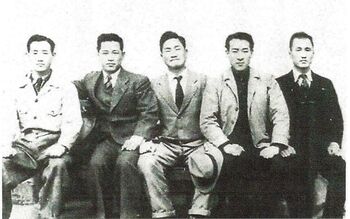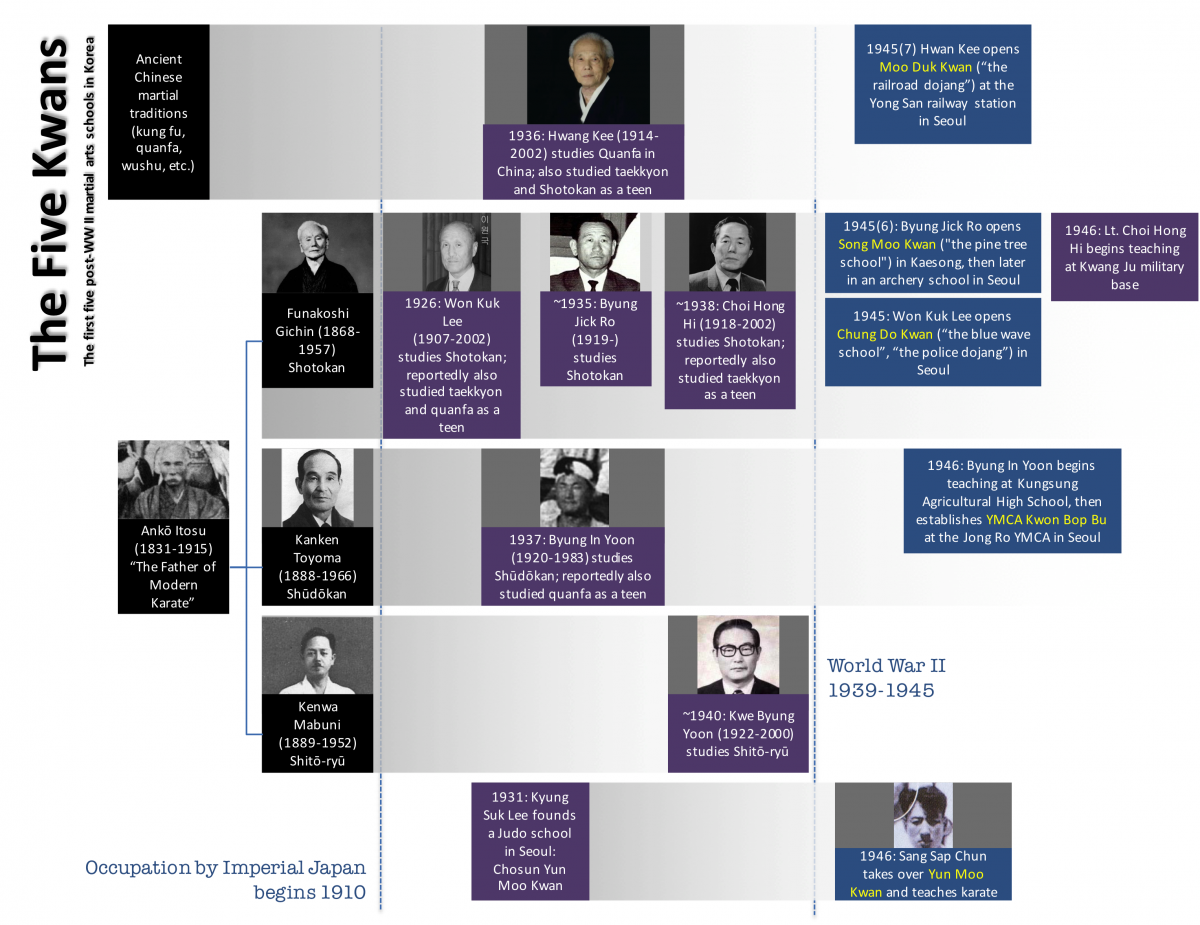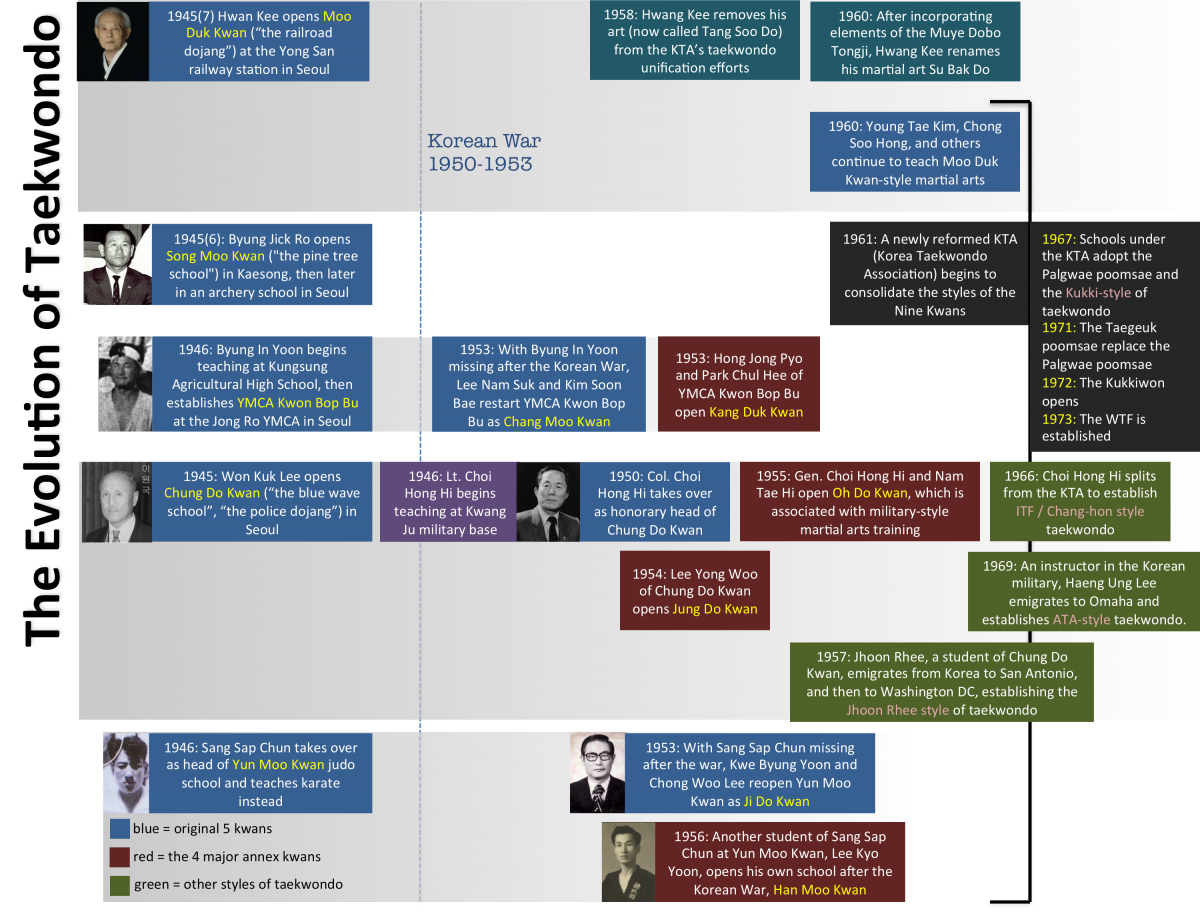 The phrase The Nine Kwans is used to refer to nine of the most prominent martial arts schools to open in Korea following the end of Japanese occupation at the end of World War II: five school opening before the Korean War (The Five Kwans) and four major schools opening after the Korean War. Each school practiced its own martial arts style, so sometimes the name of a kwan is also used to refer to the style of martial art practiced by that school. We say "nine schools" but in fact many of these schools later went on to open annex locations that practiced similar styles; utlimately the total number of schools in Korea numbered much more than nine.
The phrase The Nine Kwans is used to refer to nine of the most prominent martial arts schools to open in Korea following the end of Japanese occupation at the end of World War II: five school opening before the Korean War (The Five Kwans) and four major schools opening after the Korean War. Each school practiced its own martial arts style, so sometimes the name of a kwan is also used to refer to the style of martial art practiced by that school. We say "nine schools" but in fact many of these schools later went on to open annex locations that practiced similar styles; utlimately the total number of schools in Korea numbered much more than nine.
During the 35-year Japanese occupation of Korea (1910-1945), the practice of many Korean folk traditions (including martial arts) was prohibited. During the occupation, Korean men were sometimes conscripted into the Japanese military; there they might learn Karate as part of their military training. In other cases, the men who started the Nine Kwans had previously traveled to China or Japan studying martial arts during their travels. In a few cases, some men had the opportunity to study Taekkyon in secrecy during the occupation.
When the occupation ended, new martial arts schools immediately began to open in Korea, primarily combining elements of Karate, Taekkyon, and Kung Fu. It was not uncommon for these schools to borrow space to operate; for example Moo Duk Kwan would use storage rooms at railroad stations; Chang Moo Kwan originally operated out of a local YMCA, etc.
After the Korean War, students from the original Five Kwans began opening their own schools (these were called "annex kwans"). By 1960, there were 40 kwans in Korea. Shortly after the Korean War, at the urging of the South Korean government, the Korea Taekwondo Association (KTA) was established to consolidate and unify the kwans. By 1974, the KTA had succeeded in consolidating the 40 schools into the 9 schools shown here, the "major" post-war martial arts schools in Korea. By 1978 the KTA had coordinated the Unification Proclamation, in which all 9 remaining kwans agree to abide by Kukkiwon-style taekwondo and rank promotions. Note however that many of the schools split during this period, with some factions still practicing (even today) their original martial arts styles.
| Kwan | Founded | Founder | Influences | Meaning of Name | Also Known As | Known For | |
|---|---|---|---|---|---|---|---|
| These first five schools were started after World War II, but before the Korean War; these are the Five Kwans. | |||||||
| Chung Do Kwan | 1944 | Kyuk Won Lee |
Karate Taekkyon Kung Fu |
"Blue Wave" School (youthful vigor) | "National Police dojang" |
High Kicks Side Kicks |
|
| Song Do Kwan | 1944 | Byung Jick Ro |
Karate Kung Fu |
"Pine Tree School" (green and long-lived) |
Later bcame known as Song Moo Kwan |
||
| Moo Duk Kwan | 1946 | Hwang Kee |
Kung Fu Karate Muye Dobo Tongji |
- | "The Railroad Dojang" |
Taoist philosopy Development of Tang Soo Do The use of Midnight Blue rather than Black Belts |
|
| YMCA Kwon Bop Bu | 1946 |
Byung In Yoon then later Lee Nam Suk and Kim Soon Bae |
Karate Kung Fu |
School for Martial-Arts Development | Later became known as Chang Moo Kwan | ||
| Yun Moo Kwan | 1946 | Sang Sap Chun |
Karate Kung Fu |
School for Martial Study | Later became known as Ji Do Kwan
(School for Wisdom's Way) |
As Jidokwan, known for excellence in tournment sparring | |
| The following schools were started after the Korean War, by students of the first five schools; for this reason they are called Anex Kwans. | |||||||
| Han Moo Kwan | 1954 | Lee Kyo Yoon | Yun Moo Kwan | ||||
| Oh Do Kwan | 1955 |
Choi Hong Hi Nam Tae Hi Han Cha Kyo |
Chung Do Kwan | School of My Way | |||
| Kang Duk Kwan | 1953 |
Park Chul Hee Hong Jong Pyo |
Chang Moo Kwan | ||||
| Jung Do Kwan | 1956 | Lee Yong Woo | Chung Do Kwan | School of the Righteous Way | |||


